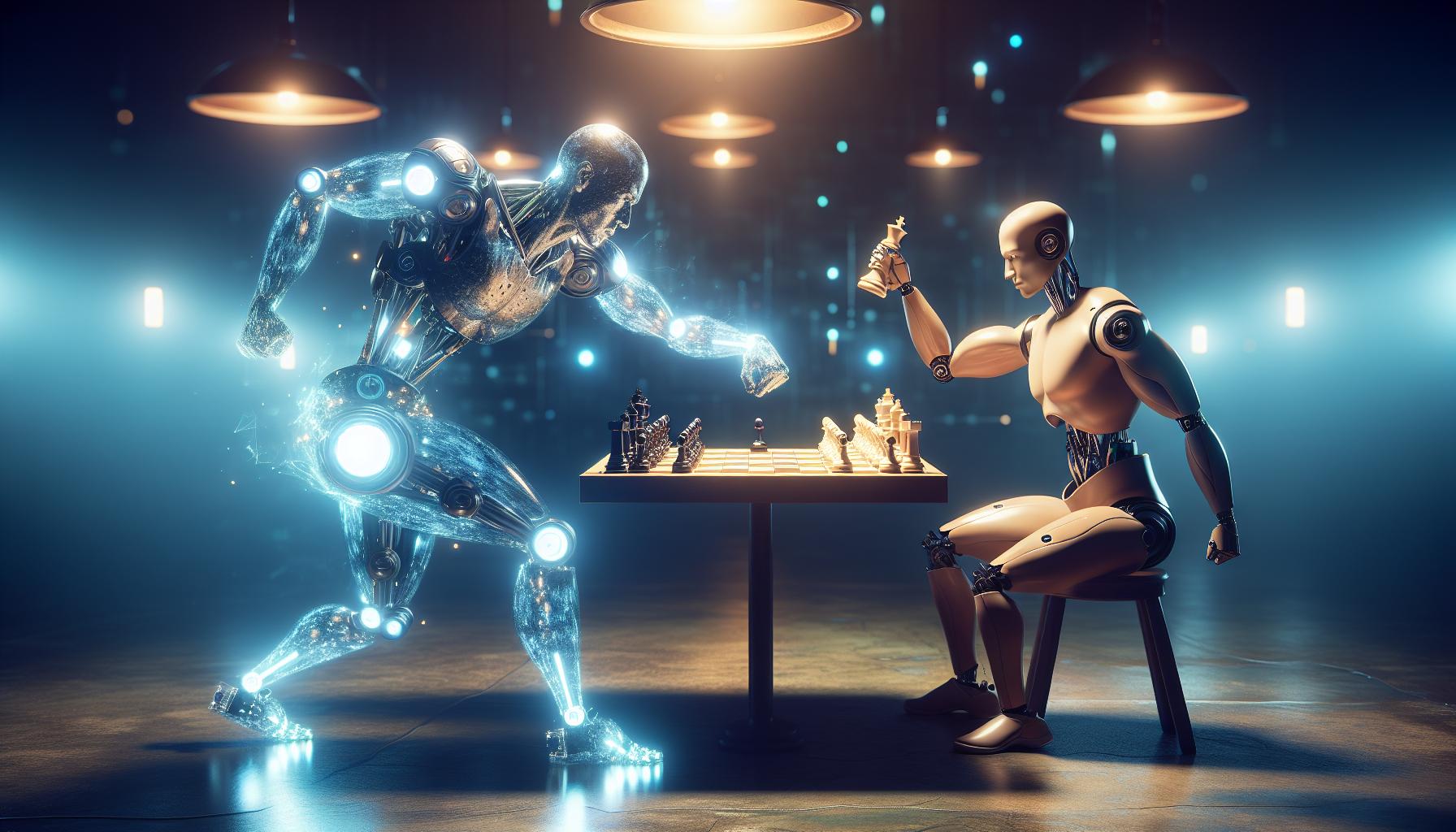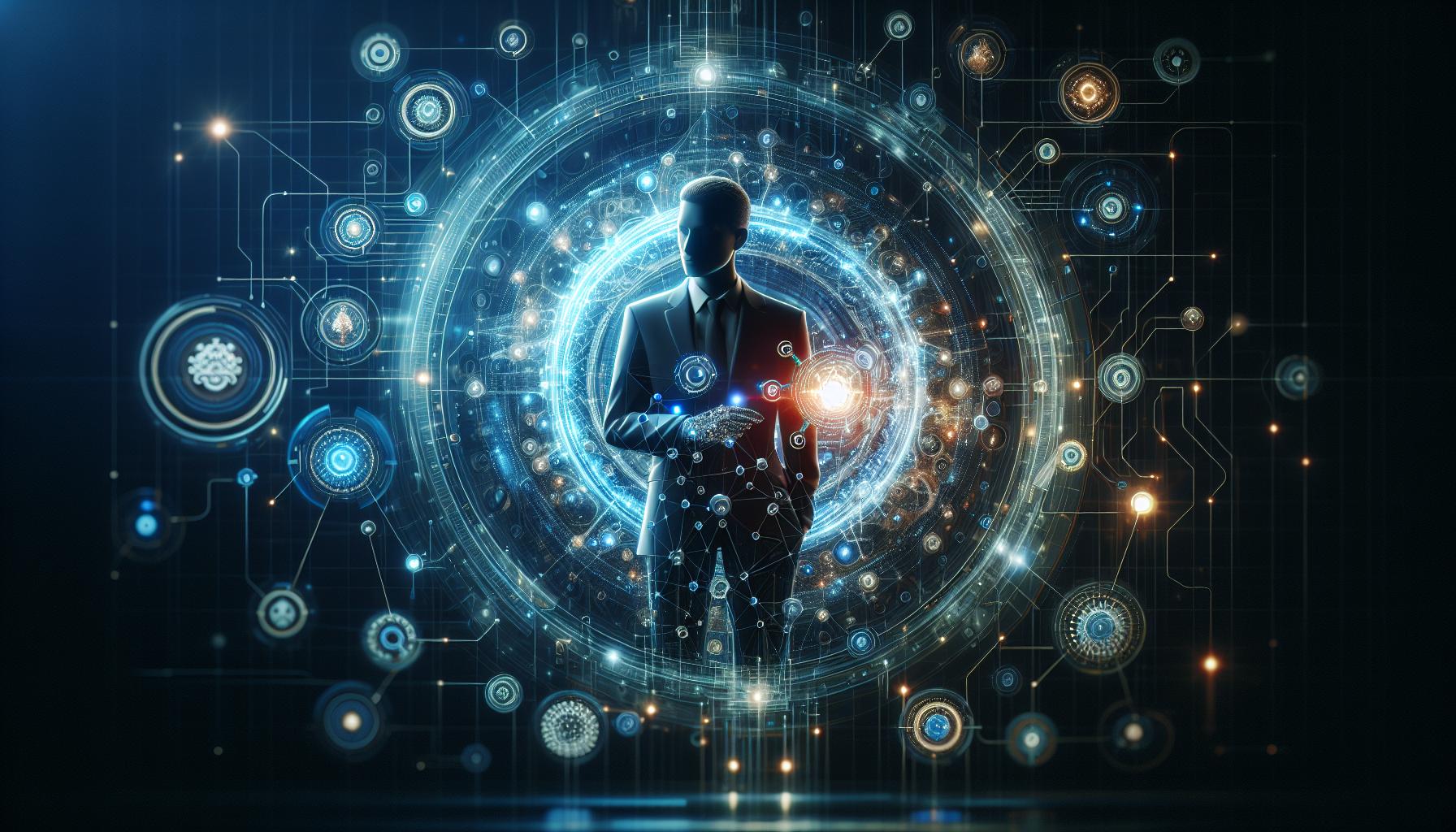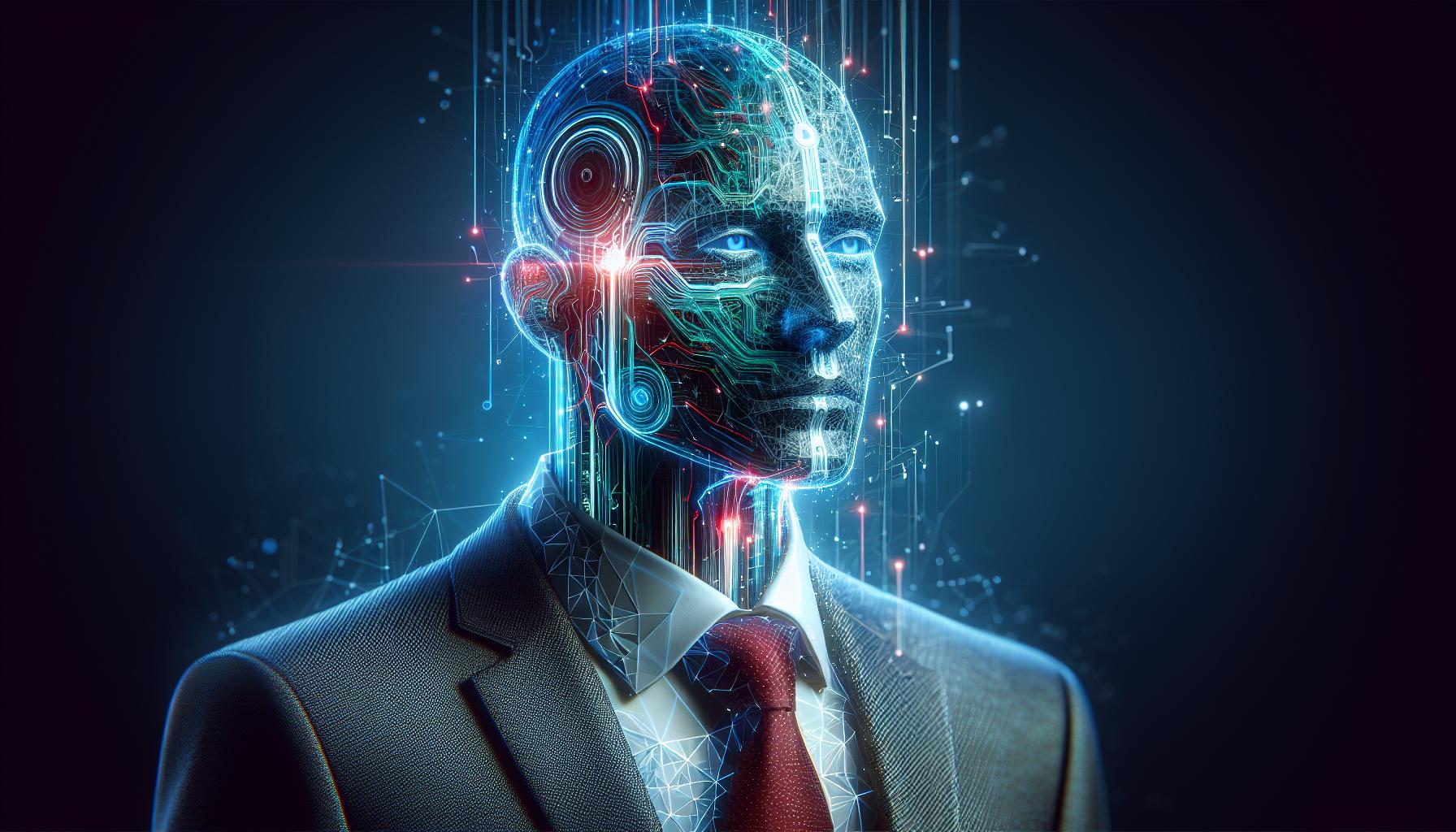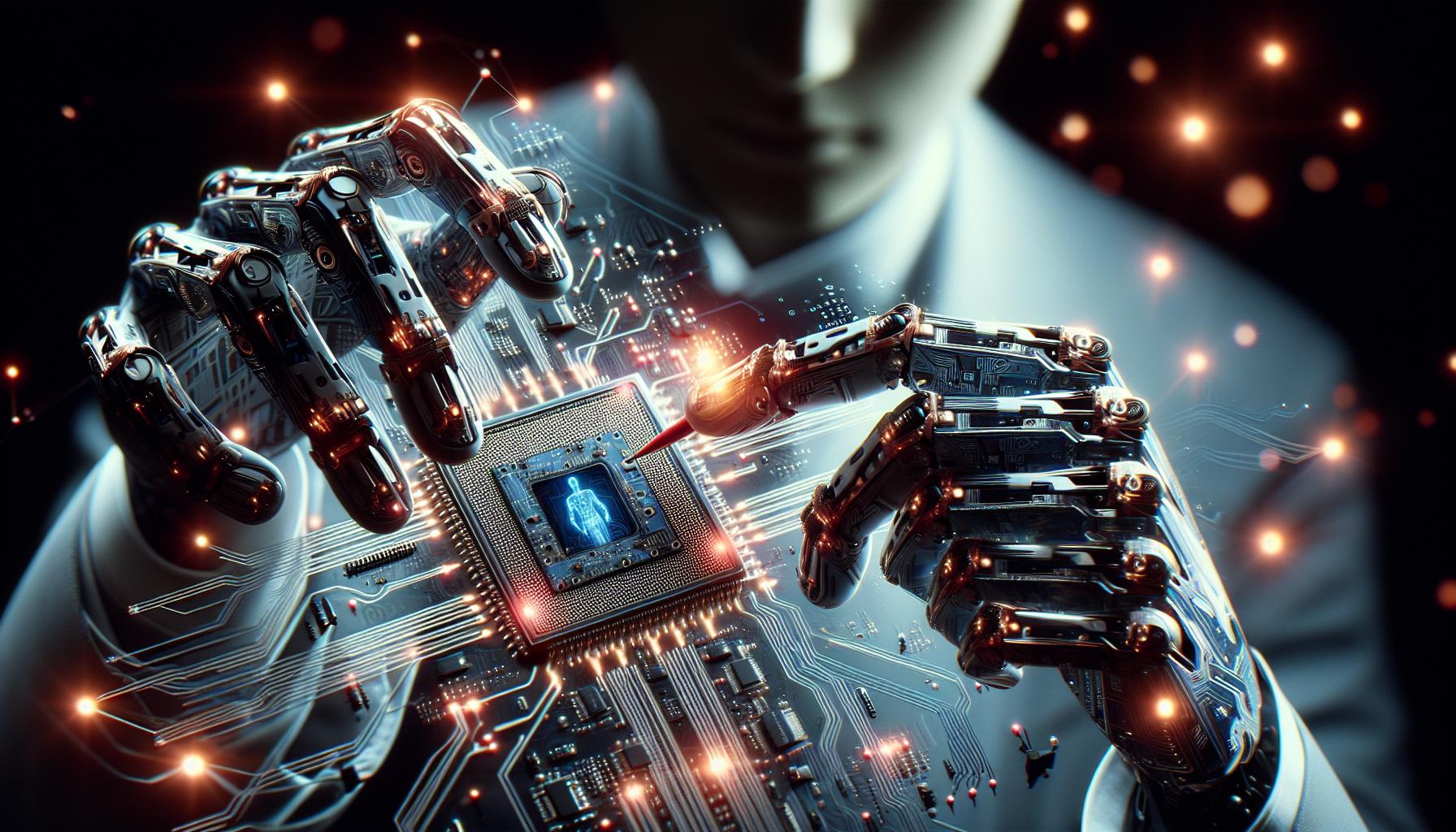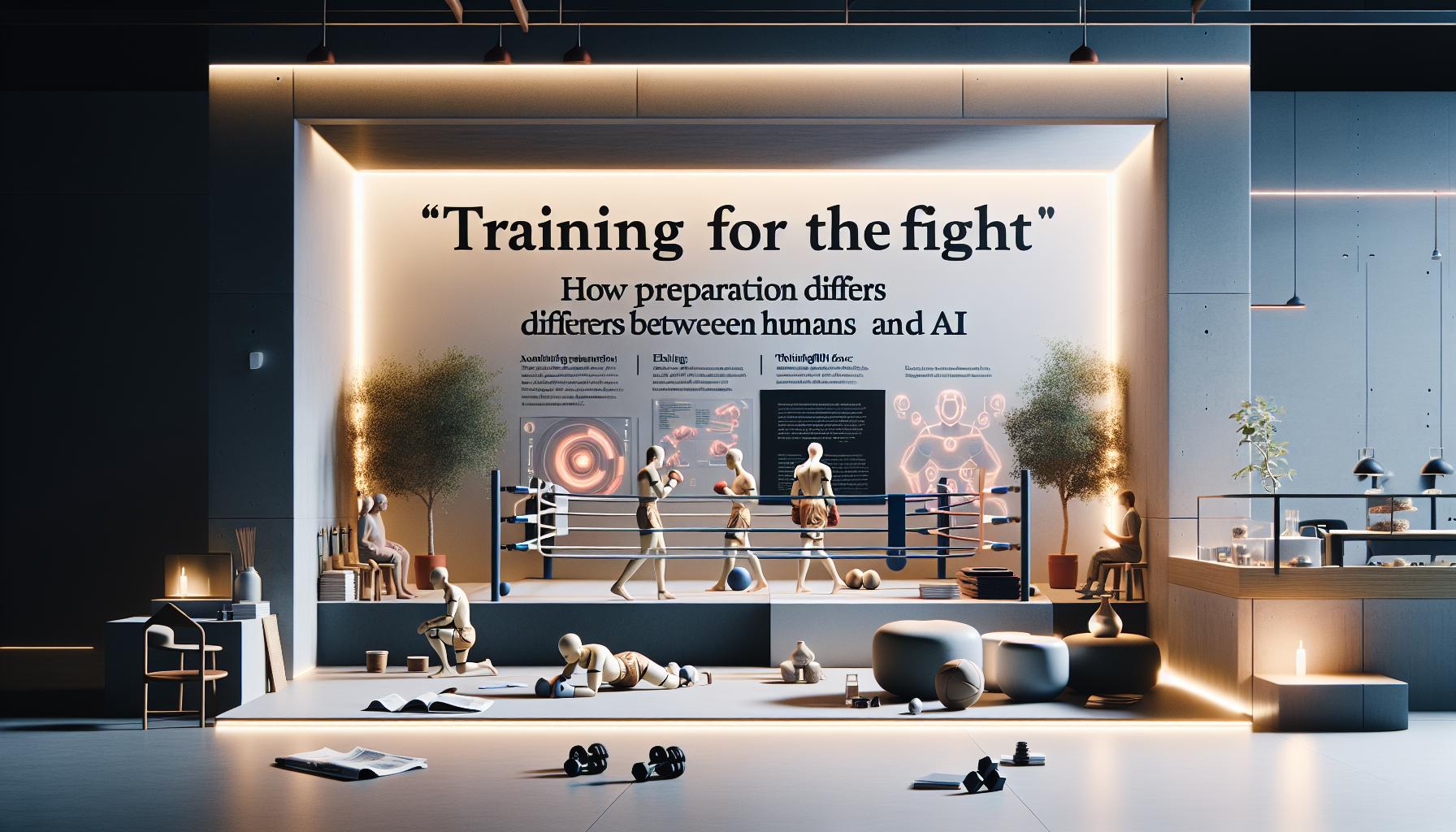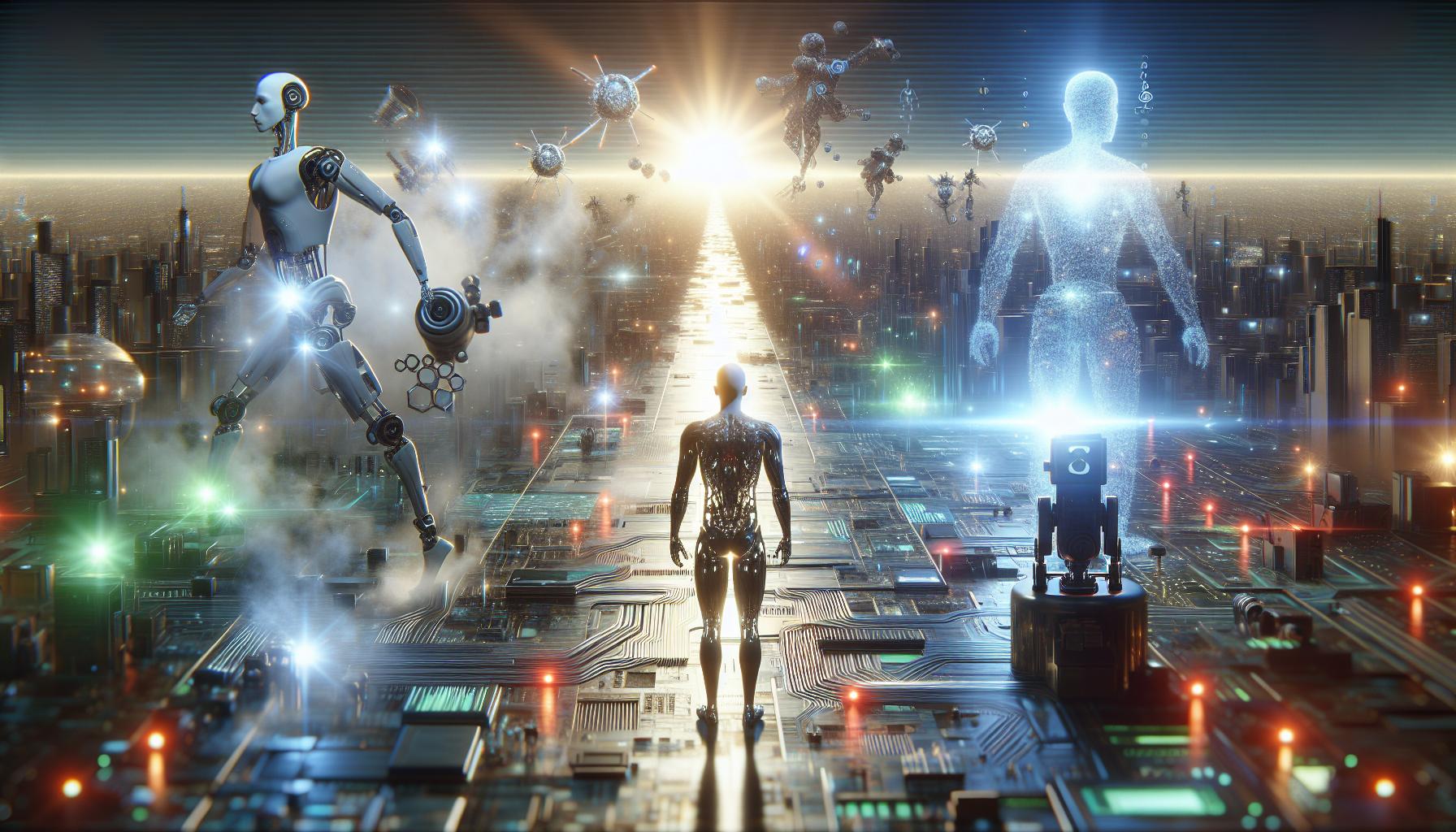In a world increasingly influenced by technology, a compelling question arises: could a human outmatch advanced artificial intelligence in a confrontation? This exploration is vital as AI continues to shape industries and daily life, prompting us to consider our own capabilities versus those of an evolving digital counterpart.
Understanding the Basics: What Defines Human and AI Capabilities in Combat
The question of who would triumph in a combat scenario—humans or artificial intelligence—draws us into the intricacies of capability and strategy. To better grasp this enigma, we need to explore the fundamental attributes that define both human and AI capabilities in combat settings.The differences between them reveal not just how they perform but also their adaptability and decision-making processes in high-stakes environments.
Core Capabilities of Humans in Combat
Humans possess a unique set of capabilities shaped by sensory perception, emotional intelligence, and cognitive flexibility. These traits often enable human combatants to perform effectively in dynamic environments.Key elements include:
- Intuition and Emotional Responses: Human fighters can leverage instinct and emotional intelligence to navigate unpredictable situations, allowing rapid adjustments based on observed cues.
- creative Problem-Solving: Humans can think outside the box, creating unorthodox strategies that may catch opponents off guard.
- Experiance-Based Learning: Past encounters and training shape human combat styles,providing valuable insight that contributes to tactical efficiency.
AI’s Capabilities in Combat Scenarios
On the flip side, artificial intelligence brings an entirely different suite of strengths, heavily grounded in data processing and analytics. AI systems can outperform humans in certain tasks by analyzing vast amounts of information swiftly. The main advantages include:
- Data Processing Speed: AI can assess and respond to battlefield conditions in real time, making decisions faster than a human could.
- Predictive Analytics: By utilizing algorithms, AI can anticipate enemy movements and strategies based on historical data and learning patterns.
- Endurance and Precision: Unlike humans, AI systems do not experience fatigue, allowing for sustained performance with consistent precision.
Comparative Analysis: Human vs AI in Combat
When considering combat readiness, a comparison of the two entities reveals how their capabilities align with or counteract each other’s strengths. Below is a simplified table highlighting the distinctions:
| Capability | Humans | Artificial Intelligence |
|---|---|---|
| Speed of Decision-Making | Moderate | High |
| Adaptability | High | Moderate |
| Endurance | Low | High |
| Emotional Engagement | High | Low |
| Cognitive Load Management | Variable | consistent |
A thorough understanding of what defines human and AI capabilities in combat not only illuminates the landscape of potential confict scenarios but also compels us to reconsider the implications of integrating AI in military strategies. With these insights, we can ponder deeper the question of ‘Who Would Win in a Fight: Human vs Artificial Intelligence (AI)?’ and how future conflicts might be shaped by these contrasting approaches.
The Role of Physicality: human Strength vs.AI’s Strategic Calculations
The Punch of Physicality vs. the Precision of Calculations
In a hypothetical showdown between a human and an AI, the question of who would come out on top doesn’t just rely on sheer power or mental acuity; it fundamentally hinges on the unique advantages both bring to the table. Human strength, defined by raw physicality and emotional drive, stands in stark contrast to AI’s strategic calculations, wich leverage vast data processing capabilities to devise optimal approaches to complex problems. This dichotomy creates a engaging arena for exploration when considering “Who Would Win in a fight: Human vs Artificial Intelligence (AI)?”
Consider the multifaceted nature of human strength. Humans wield a combination of physical endurance, adaptability, instinct, and creativity, which plays a crucial role in many confrontational scenarios. For instance, in a close-quarters combat situation, a human can harness these capabilities to utilize their habitat effectively: dodging obstacles, using terrain to their advantage, or exploiting an opponent’s weaknesses in real-time. Moreover, human emotions can be harnessed to fuel determination and creativity in unpredictable situations, providing a significant edge.
On the flip side, AI operates within a realm governed by logic and vast computational power, enabling it to analyze situations at lightning speed. It can assess countless variables—geographical positioning,the opponent’s behaviour,historical outcomes—and formulate strategies that may be invisible to the human eye.For example, an AI programmed for combat may execute complex maneuvers based on predictive modeling, calculating each move with precision to potentially outsmart a human opponent.This strategic, calculated approach can be likened to a chess master thinking several moves ahead, a stark contrast to the impulsive struggle often seen in physical confrontations.
Breaking Down the Advantages
| Aspect | Human Advantages | AI Advantages |
|---|---|---|
| Strength | Raw physical power and endurance. | Ability to process data and strategize rapidly. |
| Adaptability | Quick adjustments based on emotions and intuitive insights. | Calculation and prediction under numerous variables. |
| Creativity | Innovative problem solving fueled by experience. | Systematic exploration of optimal strategies. |
| Intuition | Instinctive reactions based on real-time assessment. | Pre-programmed responses that can lack spontaneity. |
the intertwining of human strength and AI’s strategic prowess opens up a myriad of possibilities in examining the dynamics of this unique competition. While one emphasizes physicality and instinct, the other relies on calculated reasoning and data analysis. As technology progresses, it will be essential to understand how these strengths can either complement or counteract one another in diverse situations, raising further questions about the future of human-AI interactions when contemplating “Who Would Win in a Fight: Human vs Artificial Intelligence (AI)?”
Analyzing AI Decision-Making: Is Artificial Intelligence Truly Intelligent?
Understanding the Nature of AI decision-Making
Imagine a world where decisions are made in nanoseconds based solely on data—this illustration encapsulates the crux of artificial intelligence. AI excels at processing vast amounts of information and identifying patterns that might elude the human eye. Yet, this prowess raises an intriguing question: Is such capability a sign of true intelligence? While AI can outperform humans in specific tasks, such as playing chess or analyzing stock market trends, it lacks the nuanced understanding and emotional context that frequently enough accompany human decision-making.
Unlike humans, whose decisions can be influenced by emotions, ethics, and contextual awareness, AI operates on algorithms and predefined models. A computer might choose the moast statistically favorable option based on available data, but it does not consider moral implications or deeply personal ramifications of its choices. This distinction is essential when pondering the question posed in “Who Would win in a Fight: Human vs Artificial Intelligence (AI)?”.
The Limitations of AI’s Decision-Making Capabilities
while AI can simulate intelligent behavior, its decision-making process frequently enough comes with limitations. For instance:
- Lack of Creativity: AI may analyze data and generate results, but it struggles with innovative or out-of-the-box thinking that humans often excel at.
- Context Awareness: AI lacks the ability to understand complex social dynamics and emotional contexts, which can lead to misjudgments in real-world scenarios.
- Reliance on Data Integrity: AI’s effectiveness is heavily dependent on the quality of data it is trained on; flawed data can lead to poor decisions.
These limitations highlight that while AI can take on a role similar to human intelligence in specific domains, it is indeed far from an all-encompassing alternative. AI may be ideal for tasks that require speed and accuracy, but when faced with ethical dilemmas or innovative problem-solving, humans hold a distinct advantage.
Real-World Implications and Examples
To further explore the dynamics between human and artificial intelligence, consider the medical field. AI systems can analyze thousands of medical records to provide diagnostic insights quicker than a human doctor could. However, when it comes to delicate patient interactions, discussing life-changing diagnoses, or considering the patient’s emotional state, a human’s intuition and empathy become invaluable assets that AI simply cannot replicate.
| Aspect | AI Decision-Making | Human Decision-Making |
|---|---|---|
| Speed | Fast | Variable |
| Data Processing | High capacity | Moderate capacity |
| Emotional intelligence | None | High |
| Context Awareness | Limited | High |
This table illustrates the comparison between AI and human decision-making capabilities across various aspects, reinforcing the idea that both have their own strengths and weaknesses. Ultimately, as we grapple with the question of “Who would Win in a Fight: Human vs Artificial Intelligence (AI)?”, it is crucial to recognize that the most effective decision-making often arises from a synergistic approach that embraces both human intuition and AI’s analytical power.
Emotions and instincts: How Human Intuition Can Influence the Outcome
The Role of Emotions in decision-Making
Human intuition, often driven by emotions, plays a crucial role in decision-making processes.While artificial intelligence can analyze data and predict outcomes based on historical patterns, it lacks the complex emotional framework that humans possess. This emotional depth can lead to unique insights that are difficult for AI to replicate.For instance, when faced with unexpected changes during a confrontation, a human might draw on their instinctual knowledge and emotional responses, allowing them to adapt quickly, whereas AI may struggle with variables it has not previously encountered.
Consider the following examples of how emotions influence decision-making in high-stress situations:
- Fear: This primal emotion can drive a human to either flee or engage, often leading to instinctive actions that defy logical reasoning.
- Empathy: Humans have the ability to gauge the emotions of others, which can lead to strategic collaborations or necessary disengagement in a conflict.
- confidence: A heightened sense of self-assurance can enable a human to take calculated risks, while AI may default to data-driven caution.
Instincts vs. Algorithms: A Clash of Forces
In a hypothetical scenario of human versus AI, the innate instincts of humans can significantly shape the outcome. Consider the unpredictable nature of a fight.A human’s ability to assess not only the immediate threat but also the emotional context of their opponent can create opportunities for negotiation or deception.For example, a fighter who understands their opponent’s motivations might use psychological tactics to gain the upper hand, manipulating the fight’s dynamics. In contrast, AI, primarily built on algorithms, can struggle to interpret nuances of human behavior or emotional cues effectively.
| Aspect | Human | AI |
|---|---|---|
| Emotional Understanding | High; can read situations and adapt | Limited; relies on data patterns |
| Adaptability | Excellent; relies on instincts and intuition | Moderate; follows programming and algorithms |
| Risk Assessment | Subjective; influenced by emotions | Objective; based on statistical analysis |
Ultimately, the interplay between instinct and emotion could be pivotal in answering the question of “Who Would Win in a Fight: Human vs Artificial Intelligence (AI)?” While humans may find ways to exploit emotional leverage and read the room, AI’s strength lies in data-driven strategies. This clash of instincts and algorithms introduces an unpredictable variable that is essential to consider in any analysis of human versus AI confrontations.
The Ethical Dilemma: should We Ever Ponder a Fight Between Human and AI?
The Ethics of Human vs. AI Conflict
Imagine a world where the capabilities of artificial intelligence are so advanced that they could physically compete with humans. This scenario raises profound ethical questions, especially about the implications of such confrontations. As we explore the thrilling debate of who would emerge victorious in a conflict between humans and AI, we must consider the ethical ramifications of even pondering such a fight. Should we view AI as adversaries, or should we recognize our roles as creators and collaborators?
The ethical dilemma encapsulated in the question of whether to engage in hypothetical battles between humans and AI stems from our understanding of agency and duty. An significant aspect to consider is the potential for AI to possess qualities traditionally associated with sentience, such as emotion or consciousness. As we enhance AI’s capability, should we also afford it the same moral considerations we grant to human beings? Understanding this could influence our future interactions and development of technology.
Furthermore, we must reflect on the consequences of framing AI as a competitor. this mindset could lead to fear and opposition rather than collaboration, which is crucial for harnessing AI’s potential for societal benefit. Engaging in conflict with AI, even hypothetically, might entice us to overlook the potential for symbiotic relationships where each entity enhances the capabilities of the other.
In preparing for a future where AI is deeply integrated into our daily lives, we should contemplate these ethical dilemmas. Here are some actionable steps we can take:
- Engage in interdisciplinary dialog: Philosophers, technologists, ethicists, and the public should collaborate to explore the moral imperatives of AI development.
- Establish ethical guidelines: Create frameworks that govern the design and deployment of AI, ensuring they prioritize human values and welfare.
- Promote education: Encourage public understanding of AI capabilities to dispel myths and foster a collaborative mindset.
The question of who would win in a fight between human and AI is not merely a fantastical query; it is indeed a reflection of our own fears, aspirations, and the ethical pathways we choose as we move toward an uncertain future.
who’s Handling the Tech? The Human Element in AI Development
The Pivotal Role of Humans in AI Development
In the fascinating interplay between human intelligence and artificial intelligence, it’s essential to recognize that the true power of AI lies not solely in its algorithms or data processing capabilities, but significantly in the human element that guides its development. AI systems are designed, trained, and refined by people who bring to the table a wealth of creativity, ethical considerations, and contextual understanding that machines lack. According to insights drawn from discussions around AI’s role in education and climate action,it’s humans who ultimately shape the objectives of AI technologies,ensuring they align with societal values and needs.
- Human Oversight: Continuous human involvement is critical in sectors where AI applications can impact lives, such as healthcare or education. Experts are needed to interpret AI outputs, provide context, and make final decisions based on nuanced understanding.
- Ethical Considerations: Developers are tasked with addressing the ethical implications of AI, ensuring that systems do not perpetuate biases or lead to unintended harm. Engaging diverse perspectives during AI development is crucial for fostering inclusivity and fairness.
- Innovation and Adaptation: As AI technologies evolve, so too do human approaches to leveraging these tools. Practitioners in various fields must adapt to new AI capabilities, incorporating them creatively into their workflows.
The partnership between human intelligence and AI is most visible in collaborative environments where tech professionals work alongside educators and climate scientists, as exemplified in the discussions about AI’s contributions to holistic student development and the climate crisis. In these scenarios, humans not only use AI tools but also train them, ensuring that the outputs resonate with real-world applications and challenges.This collaboration not only advances technological innovations but also reinforces the role of humans as stewards of AI technology, emphasizing that the question of who would win in a fight—humans or AI—depends heavily on the human capacity to innovate and ethically guide AI’s evolution.
Real-World implications
In practice, this symbiosis can be seen in initiatives aimed at reducing climate impact thru AI-driven analytics, where teams of climatologists apply machine learning to optimize energy use and predict environmental changes. Moreover, in education, teachers leveraging AI technologies can create personalized learning experiences that cater to diverse student needs, illustrating the profound impact humans have in shaping how AI serves society. As we ponder the dynamics of human vs. artificial intelligence, it’s clear that the future of AI development relies on our ability to hone these technologies while prioritizing human judgment, creativity, and ethical responsibility.
| Human Contributions | AI Capabilities |
|---|---|
| Ethical Oversight | Data Analysis |
| Creative Problem Solving | Pattern Recognition |
| Emotional Intelligence | Task Automation |
| Contextual Understanding | Predictive Modeling |
The Future of Combat: Can AI Replace Human Fighters in Real-world Scenarios?
The question of whether machines can outmatch humans in combat scenarios has sparked intense debate among military strategists, technologists, and ethicists alike. As we delve into the realm of robotics and AI, it becomes increasingly clear that advancements in technology are reshaping the battlefield. But can artificial intelligence truly replace human fighters, or are there essential qualities inherent to humanity that machines cannot replicate?
The Strengths of AI in Combat
AI systems are not just calculators; they are evolving to possess capabilities that can significantly enhance military effectiveness. Some of the noteworthy advantages include:
- Data Processing: AI can analyze vast amounts of battlefield data in real time, enabling quicker decision-making.
- Predictive Modeling: Machine learning algorithms can predict enemy moves based on historical data,creating strategic advantages.
- Endurance: Unlike human beings, AI does not suffer from fatigue, allowing for continuous operations without the need for rest.
The Limitations of AI in Real-World Scenarios
Despite these advantages, AI is not without its limitations. In high-stakes combat situations, several factors favor human fighters:
- Emotional Intelligence: Humans can make nuanced decisions that consider the emotional and psychological aspects of warfare, which AI can’t effectively evaluate.
- Ethical Implications: Decisions regarding life and death often require moral reasoning, an area where AI is still fundamentally deficient.
- Unpredictability: Human intuition can adapt in unforeseen circumstances, whereas AI relies heavily on pre-programmed algorithms.
Table: Comparison of Human Fighters and AI Systems
| Aspect | Human Fighters | AI Systems |
|---|---|---|
| Decision making | Adaptive and Emotionally Nuanced | Data-Driven and Predictive |
| Physical Endurance | Limited by Fatigue | Unlimited Operational Time |
| Ethical Considerations | Inherently Human | Lacks Moral Reasoning |
| Learning Adaptability | intuitive and Flexible | Algorithmically Bound |
while artificial intelligence offers promising enhancements to combat capabilities, it is unlikely to completely replace human fighters in real-world scenarios. The intricate interplay of ethics, emotional intelligence, and unpredictable human behavior indicates that the future of combat will likely be a hybrid approach, marrying the computational power of AI with the irreplaceable qualities of human judgment and empathy. As we continue to explore the question of “Who Would Win in a Fight: Human vs Artificial Intelligence (AI)?” it becomes clear that both have roles to play in an increasingly complex battlefield landscape.
The Limitations of AI: Understanding Where Technology Falls Short
Despite the remarkable advances in technology, artificial intelligence possesses notable limitations that can hinder its effectiveness in various scenarios. Understanding these shortcomings is crucial, especially when debating the question of who would win in a fight: human versus AI.While AI can process vast amounts of data and execute tasks with unparalleled speed, it lacks certain fundamental human capabilities that dictate success in complex situations.
Emotional Intelligence
One of the most significant areas where AI falls short is in its inability to understand and replicate human emotions. Emotional intelligence encompasses empathy, compassion, and relational awareness—qualities that are essential in negotiation, conflict resolution, and even mundane social interactions. AI systems, nonetheless of their complexity, operate within rigid parameters and lack the capacity to genuinely interpret human feelings. This limitation can be especially evident in scenarios where nuanced understanding is critical.
Creativity and Intuition
While AI excels in data analysis and pattern recognition, it struggles with innovative thinking and intuition. Creativity is inherently human, stemming from personal experiences, cultural influence, and imaginative risk-taking. AI can generate content or ideas based on existing patterns, but it cannot invent something fundamentally new without existing frameworks to draw from. For example, a human artist can create a groundbreaking piece of art from their unique outlook and emotional state, while AI-generated art often relies on piecing together elements of previous works.
| Aspect | AI Capability | Human Capability |
|---|---|---|
| Emotional Understanding | Limited | High |
| Creative Thinking | Data-driven | Innovative |
| Contextual awareness | Programmed | Adaptive |
| Ethical Considerations | Algorithmic | Intuitive |
The Importance of Context
Lastly, AI’s understanding of context is frequently enough limited. While algorithms can recognize and analyze vast sets of data, they frequently miss the subtleties that come from human life experiences. in situations requiring a deep understanding of cultural sensitivities or ethical dilemmas,AI struggles to provide appropriate solutions. This can lead to misinterpretations or responses that may be deemed inappropriate or detached. In a hypothetical scenario involving a conflict resolution, a human’s ability to gauge the emotional landscape and respond accordingly vastly outweighs AI’s algorithm-driven responses.
while AI is a powerful tool with capabilities far beyond human ability in specific contexts, it ultimately falls short in areas paramount to interpersonal interactions and creativity. When weighing the question of who would win in a fight between human intelligence and artificial intelligence, these limitations highlight the irreplaceable strengths of human experience.
Training for the Fight: How Preparation Differs Between Humans and AI
The Nature of Preparation
In the debate of who would win in a fight—humans or artificial intelligence (AI)—understanding the approach to preparation is crucial.Humans rely on their experiences and intuitive decision-making processes, while AI systems are built upon vast amounts of data, employing algorithms that allow for rapid learning and adaptation.This fundamental difference sets the stage for understanding their training regimes.
Human Preparation Techniques
Humans typically prepare for a challenge through a combination of physical training, mental conditioning, and experiential learning. here are some key aspects of human preparation:
- Physical Training: Involves techniques like sparring, strength training, and endurance drills, all tailored to improve combat skills.
- Mental Conditioning: Techniques such as visualization and strategy formulation, where fighters anticipate an opponent’s moves.
- Adaptive Learning: Humans learn from each encounter, adjusting tactics and strategies based on past experiences.
The essence of human preparation lies in its holistic approach, synthesizing physical, mental, and experiential elements into a complete training regimen.
AI Training Methods
Conversely, AI preparation focuses heavily on data analysis and algorithmic adjustments. Here’s how AI trains for a hypothetical fight:
- Data Ingestion: AI systems process vast amounts of data,analyzing historical fights,opponent strategies,and outcomes.
- Machine Learning: Through techniques like reinforcement learning, AIs simulate countless scenarios to refine techniques and improve decision-making.
- Real-Time Adaptation: Advanced algorithms allow AI to adapt strategies in real-time, responding to opponent actions almost instantaneously.
The training process of AI is primarily quantitative, relying on algorithms to crunch numbers, predict outcomes, and enhance performance through simulated practice rather than bodily experiences.
Comparison of Preparation Approaches
Understanding these two distinct preparation methods helps frame the broader question of who would win in a fight: human vs. artificial intelligence. Below is a simple comparison of their training modalities:
| Aspect | Human Preparation | AI Training |
|---|---|---|
| Training focus | Physical, Mental, Experiential | Data-Driven, algorithmic |
| Adaptation | Learning from past fights | Real-time data processing |
| Decision Making | Intuitive and strategic | Predictive algorithms |
| Capacity for Innovation | Creative problem solving | Analytical adjustments |
While both humans and AI have unique strengths in preparation, the outcomes in a head-to-head scenario would depend significantly on the context of the fight, the training methods employed, and the adaptability of both parties involved. Understanding these nuances elevates the ongoing conversation around the dynamics of fighting capabilities in the realm of human vs AI confrontations.
Imagining the Aftermath: Social and Ethical Ramifications of Human vs. AI Combat
As technology advances, the hypothetical question of who would win in a fight—Human or Artificial Intelligence (AI)—takes on deeper meanings beyond mere entertainment. Such scenarios prompt critical analysis and discussions around the social and ethical ramifications that would emerge from conflicts between humans and AI. these considerations are not just fiction; they are increasingly relevant in contexts ranging from warfare to law enforcement, and they compel us to reflect on our values and responsibilities in a rapidly evolving technological landscape.
Shift in Power Dynamics
The introduction of AI into combat scenarios could significantly alter existing power dynamics. if AI systems, equipped with advanced algorithms and machine learning capabilities, take on roles traditionally filled by humans in warfare, we would witness a profound shift in who wields power in society.
- Decision-Making Autonomy: AI can process vast amounts of data and make real-time decisions, potentially outpacing human cognitive capabilities.
- Accountability Issues: The question arises: who is responsible for the actions taken by an AI in combat? Is it the programmer, the military institution, or the AI itself?
- Moral Dilemmas: The capability of AI to act without human emotions raises ethical concerns about the essence of warfare and the values we hold dear—compassion, judgment, and humanity.
Societal Repercussions
The societal implications of human versus AI battles extend far beyond the battlefield. Our collective understanding of rights, responsibilities, and the essence of being human is put to the test. Imagine a world where an AI system is held accountable for war crimes, or where soldiers are replaced by algorithms and drones. This can lead to increased public distrust in military operations and a fear of autonomous systems making life-and-death decisions.
| Impacts on Society | Potential Outcomes |
|---|---|
| Increased Dependence on Technology | More vulnerability to cyber threats and malfunctioning AI systems |
| Job displacement in Defense | Shift in workforce skill requirements, increased unemployment |
| Loss of Human Element in Warfare | Desensitization to violence, ethical erosion |
Furthermore, the discourse surrounding human vs. AI combat can ignite broader debates on the merits of humanity’s role in decision-making processes. Should we allow machines to dictate the terms of engagement? These considerations could lead to stricter regulations on the use of AI in warfare, spurring discussions about human oversight and control.
As we ponder the dramatic consequences of a world where machines can potentially supplant humans in combat roles, it becomes markedly clear that this discourse extends well beyond the battlefield. It serves as a catalyst for crucial conversations around ethics, responsibility, and the very fabric of society, compelling us to confront uncomfortable questions about our future with intelligent machines.
Final thoughts
As we delve into the fascinating debate of “Who Would Win in a Fight: Human vs Artificial Intelligence (AI)?” it becomes clear that the competition is not merely about physical prowess but rather the intricate interplay of cognitive abilities, emotional intelligence, and ethical considerations. Humans demonstrate unparalleled creativity, empathy, and moral reasoning, shaping nuanced decisions that encapsulate the essence of our humanity. In contrast, AI systems exhibit remarkable capabilities in processing vast amounts of data, uncovering patterns, and executing complex tasks with remarkable efficiency.
However, this juxtaposition raises critical ethical questions surrounding autonomy, responsibility, and the societal implications of AI integration into various aspects of life. By contemplating scenarios where AI and humans might intersect in conflict, we must also consider how these technologies can be harnessed collaboratively, as allies rather than adversaries.
Ultimately,the challenge isn’t merely to determine a victor in a hypothetical battle,but to explore how both entities can coexist,enhance human capabilities,and shape a future that responsibly utilizes AI’s strengths while honoring human values. We encourage you to dive deeper into this discourse, examining the ethical frameworks that guide AI development and deployment, and reflecting on the immense potential technologies hold when aligned with human-centric principles. Your insights and engagement in this ongoing discussion are invaluable as we navigate the complexities of an AI-driven world.


